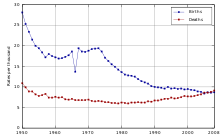1 Answer
https://www.google.ca/publicdata 127,817,277 - 2011
Source: World Bank
Demographics of Japan
<!-- /tagline --> <!-- subtitle -->
<!-- /subtitle --> <!-- jumpto -->
<!-- /jumpto --> <!-- bodycontent -->
The demographic features of the population of Japan include population density, ethnicity, education level, health of the populace, economic status, religious affiliations and other aspects of the population.
As of the most recent census (October 2010), Japan's population is 128,057,352; for March 2012 the estimated population is 127,650,000[1] making it the world's tenth most populated country. Its size can be attributed to high growth rates experienced during the late 19th and early 20th centuries.
Japan experienced net population loss in recent years due to falling birth rates and almost no net immigration, despite having one of the highest life expectancies in the world at 81.25 years of age as of 2006.[2] Using the annual estimate for October of each year, the population peaked in 2008 at 128,083,960 and had fallen 285,256 by October 2011.[3] Its population density was 336 people per square kilometer. Based on the Health and Welfare ministry estimation released in January 2012, Japan's population will keep declining by about one million people every year in the coming decades, which will leave Japan with a population of 87 million in 2060. By that time, more than 40% of the population is expected to be over the age of 65.[4] In 2012, the population for a sixth straight year of declines by 212,000 as the biggest drop on record since 1947 and also a record low of 1.03 million number of births.[5]
The population ranking of Japan dropped from 7th to 8th in 1990, to 9th in 1998, and to 10th since
http://en.wikipedia.org/wiki/Demographics_of_Japan
http://en.wikipedia.org/wiki/Japan
Thank you for posting your question on akaQA. I wish you a glorious day.
| 12 years ago. Rating: 3 | |

 andyqw
andyqw





